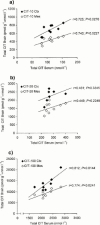In vivo steady-state pharmacokinetic outcome following clinical and toxic doses of racemic citalopram to rats
- PMID: 11309239
- PMCID: PMC1572733
- DOI: 10.1038/sj.bjp.0704015
In vivo steady-state pharmacokinetic outcome following clinical and toxic doses of racemic citalopram to rats
Abstract
The thymoleptic drug citalopram (CIT) belongs to the selective serotonin reuptake inhibitors (SSRIs) and is today extensively used in psychiatry. Further clarification of the enantiomer-selective distribution of racemic CIT in both clinical and toxic doses is highly warranted. By a steady-state in vivo paradigm, rats underwent chronic systemic exposure for 10 days by using osmotic pumps and the total as well as the individual distributions of the S- and R-enantiomers of CIT, and its metabolites in serum and two different brain regions, were analysed. In serum, the S/R ratios in the groups treated with 10, 20, or 100 mg kg(-1) day(-1) were 0.94, 0.83, and 0.34, respectively. The ratios were almost the same in the brain regions. In the group treated with 100 mg kg(-1) day(-1), the serum and brain total CIT levels were found to be 20 times and 6 - 8 times higher than in the rats treated with 10 or 20 mg kg(-1) day(-1), respectively. In all groups, the CIT levels were higher in brain tissue as compared to serum. In a spontaneous open-field behavioural test, a correlation between clinical and toxic drug concentrations was observed. In conclusion, the R-enantiomer was present in an increased proportion compared with the S-enantiomer when higher steady-state CIT concentration was prevailing. This is of particular interest, since the S-enantiomer is responsible for the inhibition of serotonin reuptake in vitro. The present data may be of importance, as full understanding on where different racemic or enantiomeric drug effects of CIT and its main metabolites are unravelled.
Figures



Similar articles
-
Pharmacokinetic and pharmacodynamic responses to chronic administration of the selective serotonin reuptake inhibitor citalopram in rats.Clin Neuropharmacol. 1999 Nov-Dec;22(6):327-36. Clin Neuropharmacol. 1999. PMID: 10626092
-
Dynamic and kinetic effects of chronic citalopram treatment in experimental hepatic encephalopathy.Clin Neuropharmacol. 2000 Nov-Dec;23(6):304-17. doi: 10.1097/00002826-200011000-00003. Clin Neuropharmacol. 2000. PMID: 11575864
-
Stereoselective single-dose kinetics of citalopram and its metabolites in rats.Chirality. 2003 Aug;15(7):622-9. doi: 10.1002/chir.10266. Chirality. 2003. PMID: 12840828
-
Differences in the dynamics of serotonin reuptake transporter occupancy may explain superior clinical efficacy of escitalopram versus citalopram.Int Clin Psychopharmacol. 2009 May;24(3):119-25. doi: 10.1097/YIC.0b013e32832a8ec8. Int Clin Psychopharmacol. 2009. PMID: 19367152 Review.
-
[Escitalopram: a selective inhibitor and allosteric modulator of the serotonin transporter].Encephale. 2007 Dec;33(6):965-72. doi: 10.1016/j.encep.2007.11.001. Epub 2007 Dec 11. Encephale. 2007. PMID: 18789789 Review. French.
Cited by
-
Acute effects of combining citalopram and pindolol on regional brain serotonin synthesis in sham operated and olfactory bulbectomized rats.Neurochem Int. 2009 Mar-Apr;54(3-4):161-71. doi: 10.1016/j.neuint.2008.08.012. Epub 2008 Nov 27. Neurochem Int. 2009. PMID: 19073228 Free PMC article.
-
Involvement of serotonin 5-HT3 receptors in the modulation of noradrenergic transmission by serotonin reuptake inhibitors: a microdialysis study in rat brain.Psychopharmacology (Berl). 2013 Sep;229(2):331-44. doi: 10.1007/s00213-013-3112-y. Epub 2013 May 2. Psychopharmacology (Berl). 2013. PMID: 23636303
-
Neonatal citalopram exposure decreases serotonergic fiber density in the olfactory bulb of male but not female adult rats.Front Cell Neurosci. 2013 May 10;7:67. doi: 10.3389/fncel.2013.00067. eCollection 2013. Front Cell Neurosci. 2013. PMID: 23675318 Free PMC article.
-
R-citalopram functionally antagonises escitalopram in vivo and in vitro: evidence for kinetic interaction at the serotonin transporter.Br J Pharmacol. 2004 May;142(1):172-80. doi: 10.1038/sj.bjp.0705738. Epub 2004 Mar 22. Br J Pharmacol. 2004. PMID: 15037515 Free PMC article.
-
Chronic antidepressant treatment impairs the acquisition of fear extinction.Biol Psychiatry. 2013 Jun 1;73(11):1078-86. doi: 10.1016/j.biopsych.2012.10.012. Epub 2012 Dec 20. Biol Psychiatry. 2013. PMID: 23260230 Free PMC article.
References
-
- ANDREWS J.M., NEMEROFF C.B. Contemporary management of depression. Am. J. Med. 1994;97:24S–32S. - PubMed
-
- APELQVIST G., HINDFELT B., ANDERSSON G., BENGTSSON F. Central vs peripheral spontaneous behavioral abnormalities in experimental hepatic encephalopathy. Physiol. Behav. 1997;61:851–856. - PubMed
-
- APELQVIST G., HINDFELT B., ANDERSSON G., BENGTSSON F. Diurnal and gender effects by chronic portacaval shunting in rats on spontaneous locomotor and rearing activities in an open-field. Behav. Brain Res. 1998;93:25–32. - PubMed
-
- BENGTSSON F., BUGGE M., BRUN A., FALCK B., HENRIKSSON K.G., NOBIN A. The impact of time after portacaval shunt in the rat on behavior, brain serotonin, and brain and muscle histology. J. Neurol. Sci. 1988;83:109–122. - PubMed
-
- BJERKENSTEDT L., FLYCKT L., OVERØ K.F., LINGJAERDE O. Relationship between clinical effects, serum drug concentration and serotonin uptake inhibition in depressed patients treated with citalopram. A double-blind comparison of three dose levels. Eur. J. Clin. Pharmacol. 1985;28:553–557. - PubMed
Publication types
MeSH terms
Substances
LinkOut - more resources
Full Text Sources
Research Materials

